苹果(Malus pumila Mill.)属多年生落叶乔木,是中国栽植较多的果树之一[1]。由于苹果树具有多年种植且不可移动的特点,因此在果园连年栽培管理中提供良好的土肥水管理是获得优质丰产的前提。但目前苹果园生产肥水管理中存在着有机肥、复混肥和中微量元素肥投入不足、肥料结构不平衡、肥料利用率低、土壤污染等各种问题[2-3],从而造成了果树产量下降,果实品质降低的现象。因此,科学合理施肥是实现苹果高产和品质优良的基础,也是苹果能够连年生产的重要种植条件[4]。
硅(Si)是地壳中含量第二大丰富元素,在植物生长发育中发挥着有益作用,通常被认为是植物的有益非必需元素[5]。适当的硅肥补充可使植物茎叶直挺,利于通风透光,增强植物光合作用;还可提高植物抗逆性和果实品质[6-8]。植物在生长中只能吸收溶于水的、少量的单分子硅酸[9],在农业生产中大量施用其他元素肥会减少土壤中的有效硅[10],因此如果只依赖自然环境提供的硅补充营养,即使施用氮、磷、钾肥,作物也会出现生长发育不良,果实产量和品质降低等问题,所以科学的硅肥施用在农业生产中显得尤其重要。硅肥在苹果上的应用已有较多前人研究,Wang 等[11]研究表明,硅可以提高苹果叶片叶绿素含量并促进光合作用,还可以防治苹果根腐病和树体过早衰老,促进苹果树生长和根系发育。唐岩等[12]发现对富士苹果喷施K2SiO3可以促进果实可溶性固形物和可溶性糖含量增加、挥发性物质种类和含量增加、可滴定酸含量下降,提高了果实品质。也有前人使用SiO2喷施不同品种苹果,发现均可以提高不同品种果实产量和硅含量,还可以提高果实糖度、花青素含量、香气成分含量等果实品质[8,13-14]。
精氨酸(Arginine,Arg)作为功能最多样的氨基酸之一,氮碳比最高,是多胺和一氧化氮等信号分子生物合成的前体[15]。近年来,精氨酸对植物的积极作用引起了研究者的较多关注。外源性精氨酸处理可有效激活内源性精氨酸代谢,保持蘑菇的贮藏品质,延长蘑菇的保鲜期[16]。精氨酸处理可以通过改善氮积累提高番茄果实番茄红素和维生素C 含量,进而提高番茄产量和品质[17]。精氨酸喷施处理还可以提高草莓果实品质及产量[18],但目前精氨酸在苹果生产应用中的效果尚未可知。
精氨酸硅酸盐肌醇络合物(Nitrosigine)以硅酸钾水溶液、肌醇、精氨酸混合加热制备而成。目前并无在正常生长条件下外源施加肌醇促进植物生长的报道,该络合物中肌醇的主要作用是作为增溶剂通过增强硅酸钾与精氨酸之间的氢键使硅酸钾与精氨酸络合并提高水溶解能力[19]。先前有研究表明,此络合物可作为药物应用于大鼠、母鸡、鹌鹑等动物以及人类,对动物生长发育及人体的骨骼、血管及神经都具有较多益处[20-22],但在植物中并无研究应用。因此笔者在本研究中采用精氨酸硅酸盐肌醇络合物对平邑甜茶幼苗和嘎拉/M9、富士/M9 苹果树进行处理,探究精氨酸硅酸盐肌醇络合物对苹果幼苗生长及苹果果实品质的影响,以期为苹果生产中新型硅肥应用提供理论依据。
1 材料和方法
1.1 试验地概况
试验于2023 年在山东农业大学小麦育种全国重点实验室(栽培环境温度为25 ℃;光周期为14 h光照,10 h黑暗)和山东省淄博市沂源县南麻镇现代农业科技示范园分别进行,示范园属暖温带季风区域大陆性气候。
1.2 试验材料及方案
试验材料为平邑甜茶苹果幼苗,6 年生嘎拉/M9和富士/M9 苹果树。精氨酸硅酸盐肌醇络合物制备过程:将1.474 L 28%硅酸钾水溶液加热至60 ℃,保持60 ℃温度加入205.8 g 肌醇,搅拌溶解,溶解后加入417 g 精氨酸,继续搅拌,待全部溶解后升高温度至95 ℃,加热5 min,冷却得到精氨酸硅酸盐肌醇络合物水溶液,干燥得其固体,干燥后得到的精氨酸硅酸盐肌醇络合物中精氨酸、硅酸盐、肌醇的摩尔比约为1.8∶2.1∶1.2,处理前测定精氨酸硅酸盐肌醇络合物硅含量(w)为0.41%。
在本试验中苹果幼苗共设7 个处理:(1)清水空白为对照;(2)2 mmol·L-1硅酸钾处理(2 mmol·L-1 K2SiO3);(3)6 mmol·L-1 硅酸钾处理(6 mmol·L-1 K2SiO3);(4)2 mmol·L-1 精氨酸处理(2 mmol·L-1 Arg);(5)6 mmol·L-1精氨酸处理(6 mmol·L-1 Arg);(6)2 mmol·L-1 精氨酸硅酸盐肌醇络合物处理(2 mmol·L-1 Nitrosigine);(7)6 mmol·L-1精氨酸硅酸盐肌醇络合物处理(6 mmol·L-1 Nitrosigine)。其中精氨酸硅酸盐肌醇络合物浓度均以硅浓度为基准,即2 mmol·L-1精氨酸硅酸盐肌醇络合物为2 mmol·L-1硅浓度的精氨酸硅酸盐肌醇络合物,6 mmol·L-1精氨酸硅酸盐肌醇络合物为6 mmol·L-1硅浓度的精氨酸硅酸盐肌醇络合物,为方便对比直接写为其浓度。精氨酸对照浓度则根据精氨酸硅酸盐肌醇络合物精氨酸与硅酸钾摩尔比等比换算得出。
平邑甜茶幼苗首先将种子4 ℃层积30 d后穴盘播种,长出两片真叶后选取长势一致的幼苗定植于种植盆中,供试土壤为蛭石+基质(3∶1),长出5片真叶后根施处理,每隔一周处理1次,共处理4次。
在本试验中苹果大树共设2 个处理:(1)清水空白对照;(2)30 mmol·L-1精氨酸硅酸盐肌醇络合物处理(30 mmol·L-1 Nitrosigine)。参考唐岩等[12]所筛选的苹果树K2SiO3最佳喷施浓度为0.5%,摩尔浓度计算约为30 mmol·L-1,由于精氨酸硅酸盐肌醇络合物以硅浓度为基准,因此选定30 mmol·L-1硅浓度的精氨酸硅酸盐肌醇络合物。
选取长势基本一致的苹果树,插牌标记,每处理各选取6株,于4月底开始喷施处理,每隔1月处理1次,直至苹果果实成熟,其余果树管理保持一致。
1.3 测定项目与方法
1.3.1 幼苗生长相关指标测定 在处理28 d 后,选择晴朗无云天气,于上午09:00 使用CIRAS-3 便携式光合作用测定仪(PP Systems,Haverhill,Massachusetts,USA)分别测定各处理平邑甜茶幼苗叶片光合特性,各处理重复测定12 株。测定指标:净光合速率Pn(μmol·m-2·s-1)、胞间CO2浓度Ci(μmol·mol-1)、蒸腾速率Tr(mmol·m-2·s-1)、气孔导度Gs(mmol·m-2·s-1)。
将各处理12 株幼苗洗根后分别测定平邑甜茶幼苗株高、茎粗、叶面积、叶厚、叶鲜质量、地上部及地下部干鲜质量。使用钢尺(范围0~20 cm,精度±0.1 cm)测定株高;使用电子游标卡尺(范围0~150 mm,精度±0.02 mm)测定茎粗、叶厚;将叶片平铺拍照,使用Image-J 软件测定叶面积;使用电子天平(范围0~1500 g,精度±0.01 g)测定叶鲜质量、地上部及地下部鲜质量;采用95%乙醇浸提比色法测定新鲜叶片叶绿素含量[23]。幼苗地上部及地下部使用烘箱(上海一恒,China)105 ℃杀青30 min,80 ℃烘干至恒质量,使用电子天平测定地上部及地下部干质量。3次重复。
1.3.2 苹果果实品质测定 果实于坐果期套袋,着色期摘袋,8 月初嘎拉果实成熟后和10 月底富士果实成熟后各处理随机均匀采摘苹果20~30 个,取样后带回实验室(28 ℃左右)测定,每处理选取15个苹果样品,使用电子天平称取单果质量,游标卡尺测定其纵横径,计算果形指数;使用色差仪(CR-10,Konika-Minolta,Japan)测定苹果色差(a*、b*、L*);采用盐酸-乙醇浸提法测定果皮花青苷含量[24];使用手持式折光仪(TY/HTPTD-45,Tuya,China)测定果实可溶性固形物含量;采用蒽酮比色法测定可溶性糖含量;采用酸碱滴定法测定可滴定酸含量,计算固酸比[23];使用质构仪(TA,XT plus mass spectrometer,Stable Micro Systems,England)测定果实硬度;采用咔唑比色法测定果实原果胶及可溶性果胶含量[25],计算果胶总量。3次重复。
1.3.3 硅含量测定 取适量平邑甜茶叶片、嘎拉和富士果实果皮及果肉样品分别装入羊皮纸袋,使用烘箱105 ℃杀青30 min,80 ℃烘干。烘干样品取适量使用研钵磨碎,随后取25 mg 样品于100 mL 坩埚内,加入混合溶液(HNO3、超纯水体积比为4∶3)10 mL和2 滴HF 酸,电热板200 ℃加热30 min 消解样品,难消解样品可适当增加时间,直至消解完全,在加热过程中混合溶液要及时补加。将消解完全的溶液冷却至室温后使用超纯水稀释至50 mL,使用0.22 μm有机系滤膜过滤样品5 mL,使用电感耦合等离子体发射光谱仪(ICP-OES,Thermofisher,USA)测定样品Si含量,3次重复。
1.4 数据处理与分析
使用Microsoft Excel.2019与DPS软件对试验数据采用Duncan(D)新复极差法进行差异显著性检验,采用GraphPad Prism 8软件作图。
2 结果与分析
2.1 精氨酸硅酸盐肌醇络合物对苹果幼苗生长的影响
如图1和图2所示,相比于对照,K2SiO3、Arginine和Nitrosigine处理均促进幼苗生长,其中2 mmol·L-1、6 mmol·L-1 Nitrosigine 显著提高了平邑甜茶幼苗的株高、茎粗、地上部鲜质量和地上部干质量。2 mmol·L-1、6 mmol·L-1 Nitrosigine 处理的幼苗株高比对照分别显著增加了60.65%、62.28%(图2-A),幼苗生长快;2 mmol·L-1、6 mmol·L-1 Nitrosigine处理的茎粗比对照分别显著增加27.96%、29.55%(图2-B);2 mmol·L-1、6 mmol·L-1 Nitrosigine 处理的地上部鲜质量比对照分别显著提高146.76%、167.72%(图2-C)。Nitrosigine 处理幼苗的地上部干质量虽高于Arginine处理,但无显著差异,二者都显著高于K2SiO3和对照,2 mmol·L-1 Nitrosigine 比对照、2 mmol·L-1 K2SiO3分别显著提高119.27%、63.38%,6 mmol·L-1 Nitrosigine比对照、6 mmol·L-1 K2SiO3分别显著提高128.74%、92.02%(图2-D);地下部鲜质量和干质量除精氨酸处理地下部鲜质量较高外,其余均无显著差异(图2-E~F)。
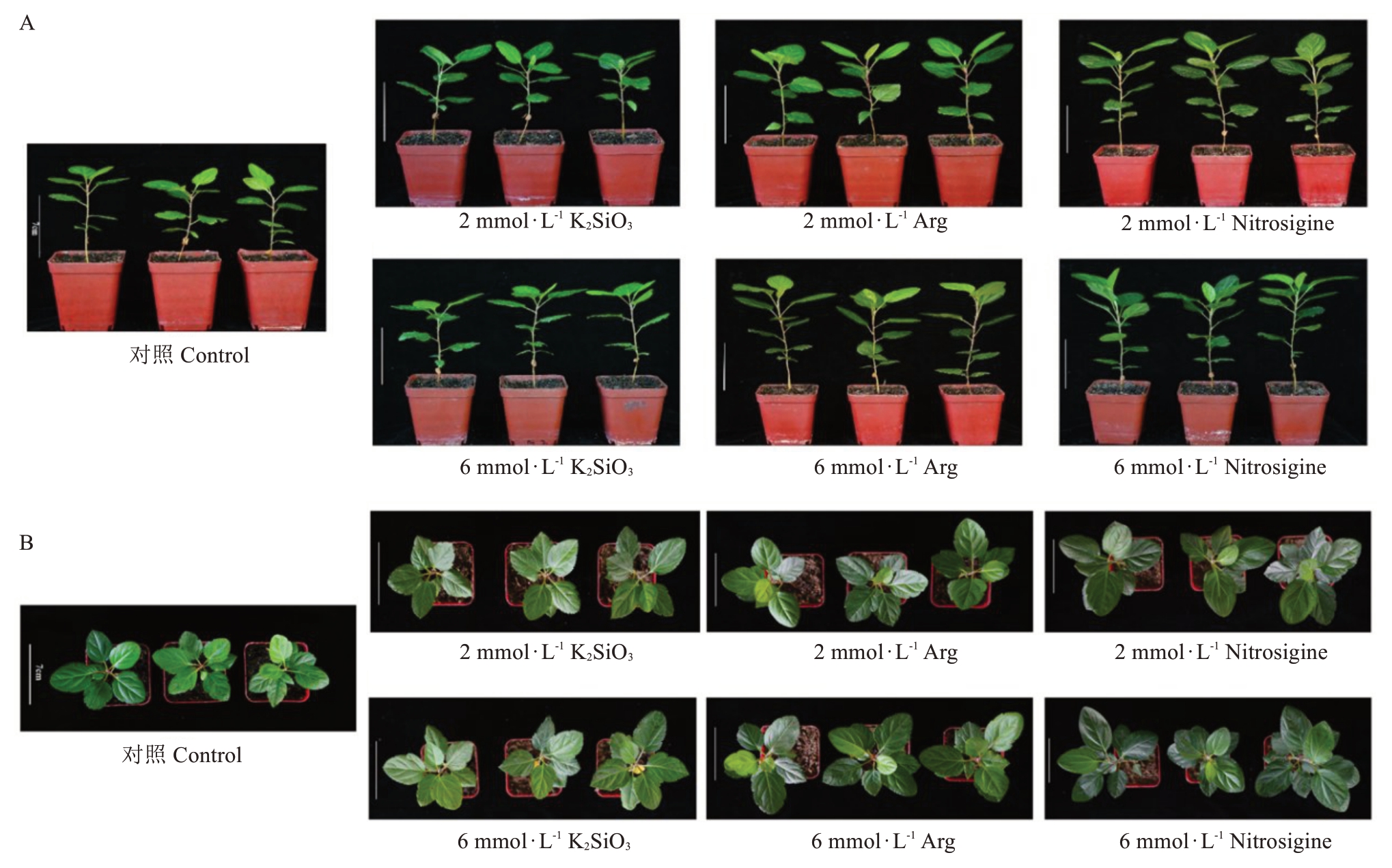
图1 精氨酸硅酸盐肌醇络合物对平邑甜茶幼苗生长的影响
Fig. 1 Effects of nitrosigine treatment on the growth of M. hupehensis Rehd seedlings
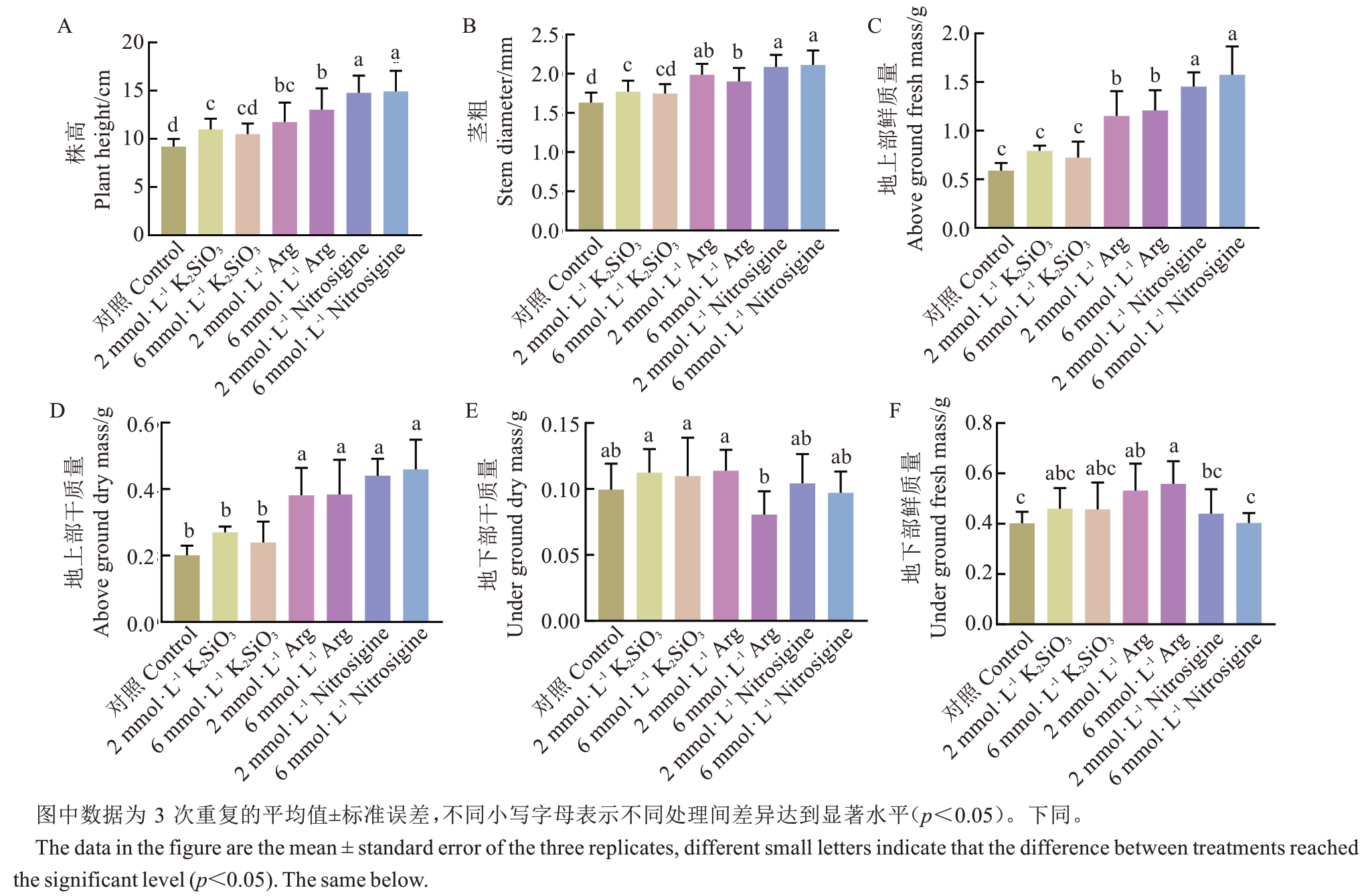
图2 精氨酸硅酸盐肌醇络合物对平邑甜茶幼苗生长相关指标的影响Fig. 2 Effects of nitrosigine treatment on the growth related index of M. hupehensis Rehd seedlings
2.2 精氨酸硅酸盐肌醇络合物对苹果幼苗叶片生长的影响
如图3 所示,Nitrosigine 处理苹果幼苗可显著影响叶片生长,外观主要表现为叶面积增加,长势旺盛,叶绿素含量显著增加,叶片呈现深绿色,其中以6 mmol·L-1 Nitrosigine 处理效果最好(图3-A)。2 mmol·L-1 Nitrosigine 处理的平邑甜茶幼苗叶面积比对照、2 mmol·L-1 K2SiO3及2 mmol·L-1 Arg显著提高119.01%、68.38%、20.39%;6 mmol·L-1 Nitrosigine处理的叶面积比对照、6 mmol·L-1 K2SiO3、6 mmol·L-1 Arg 及2 mmol·L-1 Nitrosigine 显著提高164.44%、83.89%、53.07%、20.74%(图3-B)。叶鲜质量以Nitrosigine处理显著高于其余处理,且6 mmol·L-1 Nitrosigine 比2 mmol·L-1 Nitrosigine 处理显著提高21.96%(图3-C)。叶厚及叶绿素a、叶绿素b、类胡萝卜素含量均为Nitrosigine 处理高于其余处理,2 mmol·L-1 Nitrosigine 处理的叶厚、叶片叶绿素a、b 含量、类胡萝卜素含量分别比对照显著提高67.95%、78.86%、91.81%、54.53%;6 mmol·L-1 Nitrosigine 处理的叶厚、叶片叶绿素a、b 含量、类胡萝卜素含量分别比对照显著提高75.54%、76.19%、91.13%、45.26%(图3-D~G)。

图3 精氨酸硅酸盐肌醇络合物对平邑甜茶幼苗叶片生长的影响
Fig. 3 Effects of nitrosigine treatment on leaf growth of M. hupehensis Rehd seedlings
2.3 精氨酸硅酸盐肌醇络合物对苹果幼苗光合特性的影响
如图4 所示,Nitrosigine、K2SiO3、Arginine 处理可显著提高平邑甜茶幼苗叶片净光合速率、蒸腾速率(2 mmol·L-1 K2SiO3除外)、气孔导度,并显著降低了胞间CO2 浓度(图4-A~D),且Nitrosigine 处理幼苗的净光合速率、蒸腾速率、气孔导度均高于其余处理,其中6 mmol·L-1 Nitrosigine 处理幼苗的净光合速率、蒸腾速率、气孔导度比对照分别显著提高497.00%、89.20%、136.34%(图4-A、C、D);6 mmol·L-1 Nitrosigine 处理幼苗的净光合速率、蒸腾速率比2 mmol·L-1 Nitrosigine 分别显著提高30.22%、11.68%,气孔导度无显著差异。对照的平邑甜茶苹果幼苗胞间CO2浓度显著高于其他处理(图4-B)。
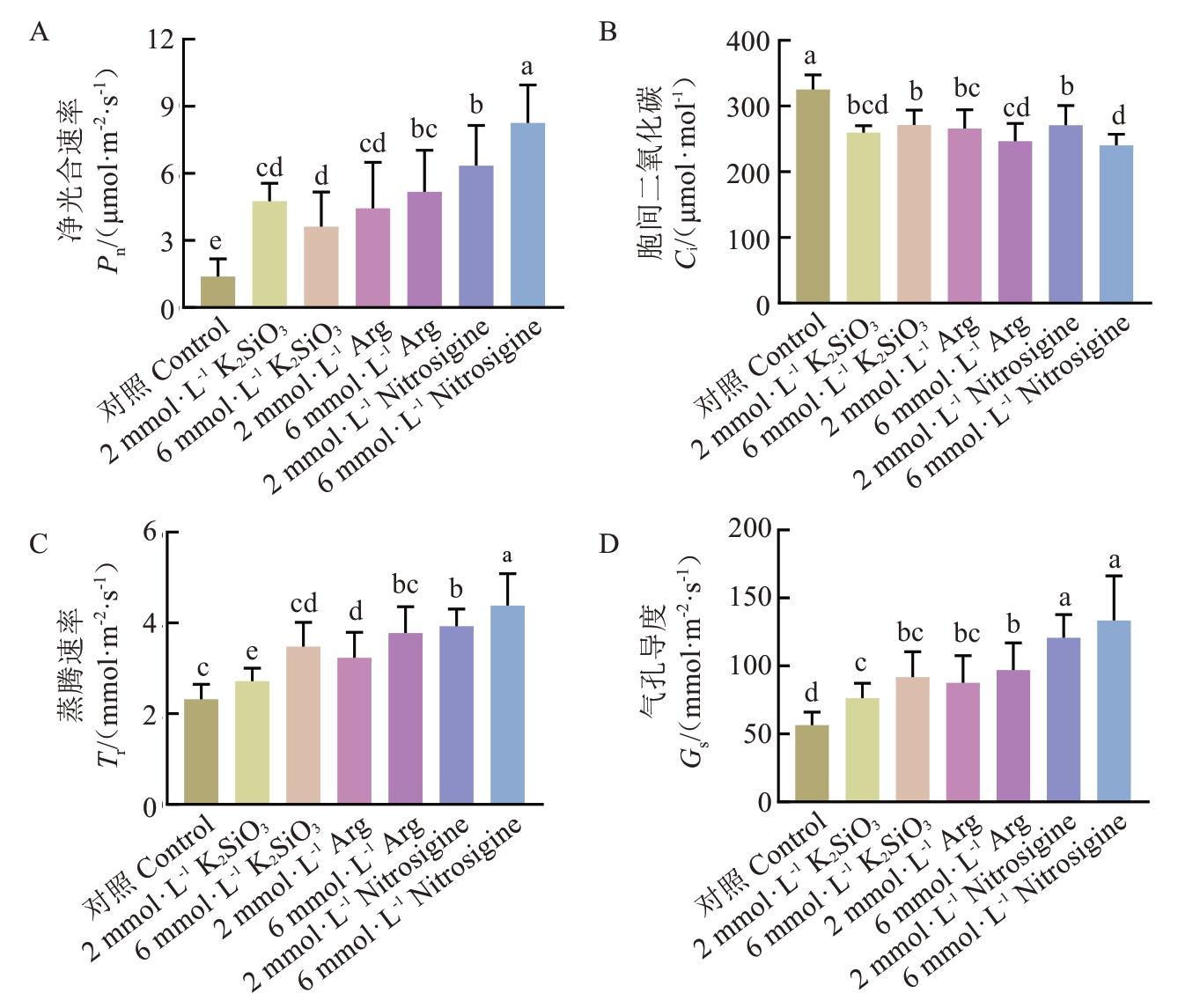
图4 精氨酸硅酸盐肌醇络合物对平邑甜茶幼苗叶片光合特性的影响
Fig. 4 Effects of nitrosigine on the photosynthetic properties of leaves of M. hupehensis Rehd seedlings
2.4 精氨酸硅酸盐肌醇络合物对苹果幼苗硅含量的影响
如图5所示,Nitrosigine及K2SiO3处理显著提高苹果幼苗硅含量。2 mmol·L-1 K2SiO3、6 mmol·L-1 K2SiO3、2 mmol·L-1 Nitrosigine、6 mmol·L-1 Nitrosigine 处理的平邑甜茶幼苗叶片硅含量分别比对照显著提高了86.11%、122.35%、116.03%、116.77%,Nitrosigine 处理与K2SiO3处理的叶片硅含量差异不显著。
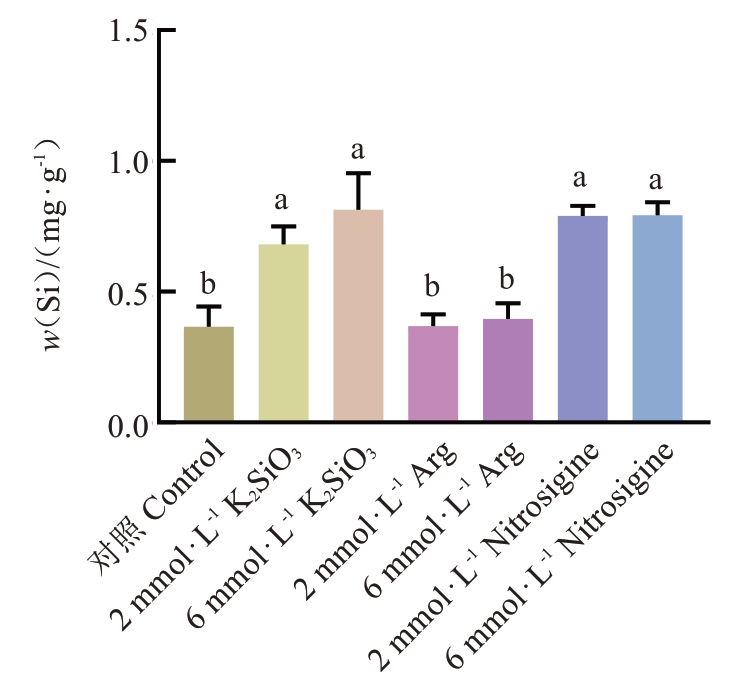
图5 精氨酸硅酸盐肌醇络合物对平邑甜茶幼苗叶片Si 含量的影响
Fig. 5 Effects of nitrosigine on Si content of leaves of M. hupehensis Rehd seedlings
2.5 精氨酸硅酸盐肌醇络合物对苹果果实外在品质的影响
前期幼苗试验结果表明,Nitrosigine 相比于K2SiO3 和Arginine 可显著促进平邑甜茶幼苗生长,为了验证其在不同品种苹果果实的施用效果,笔者将Nitrosigine 分别喷施于嘎拉/M9 及富士/M9 苹果树(图6~7)。30 mmol·L-1 Nitrosigine 喷施处理的嘎拉苹果果实果形指数比对照显著降低了3.65%(图6-C)。30 mmol·L-1 Nitrosigine 处理的嘎拉及富士苹果花青苷含量比对照分别显著提高了60.62%、6.82%;嘎拉苹果红色色差(a*)显著提升(图6-E);富士苹果红色色差(a*)显著提升,黄色色差(b*)显著降低(图7-E~F)。
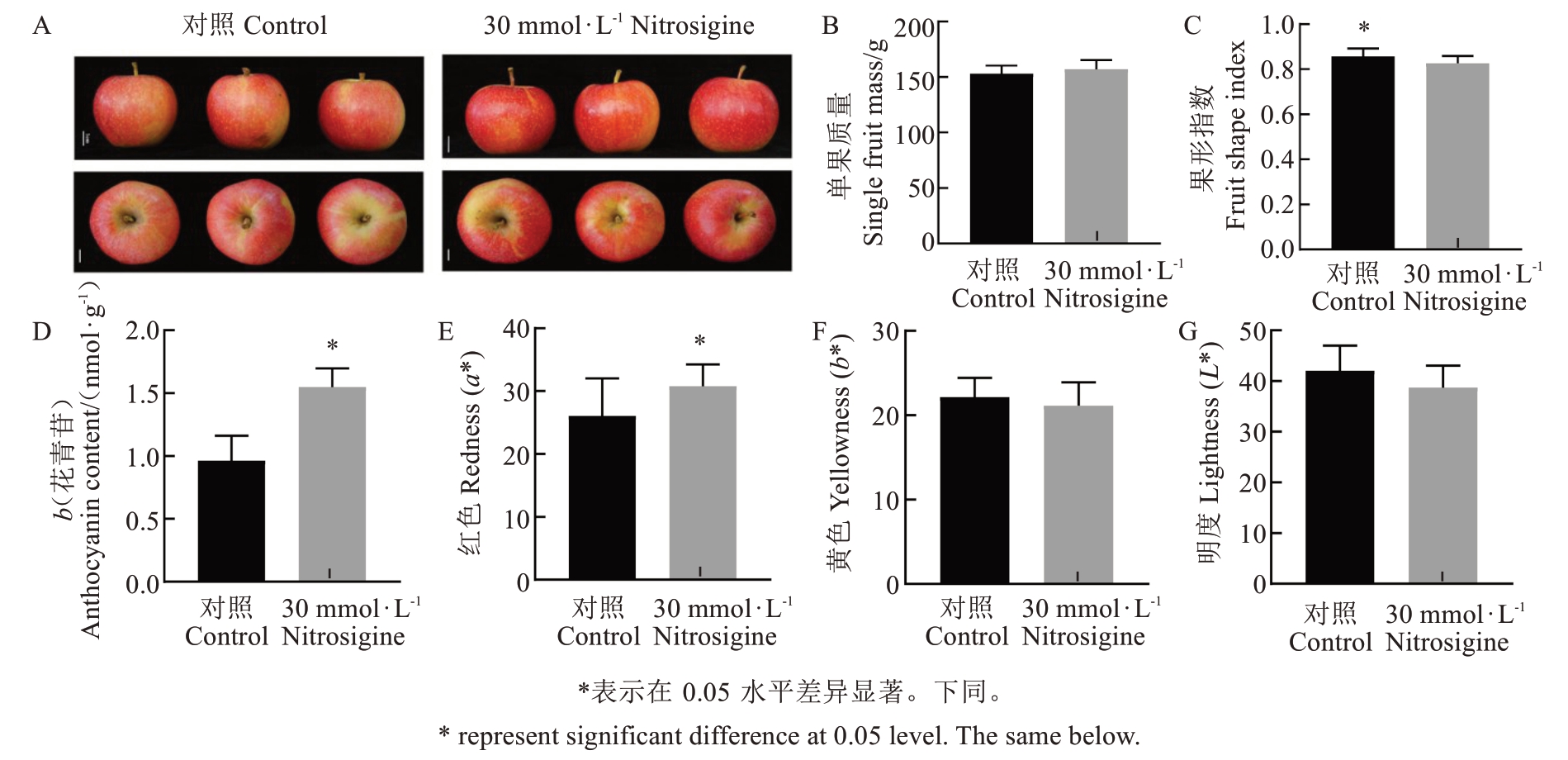
图6 精氨酸硅酸盐肌醇络合物对嘎拉果实外在品质的影响
Fig. 6 Effects of nitrosigine on the external quality of Gala fruits
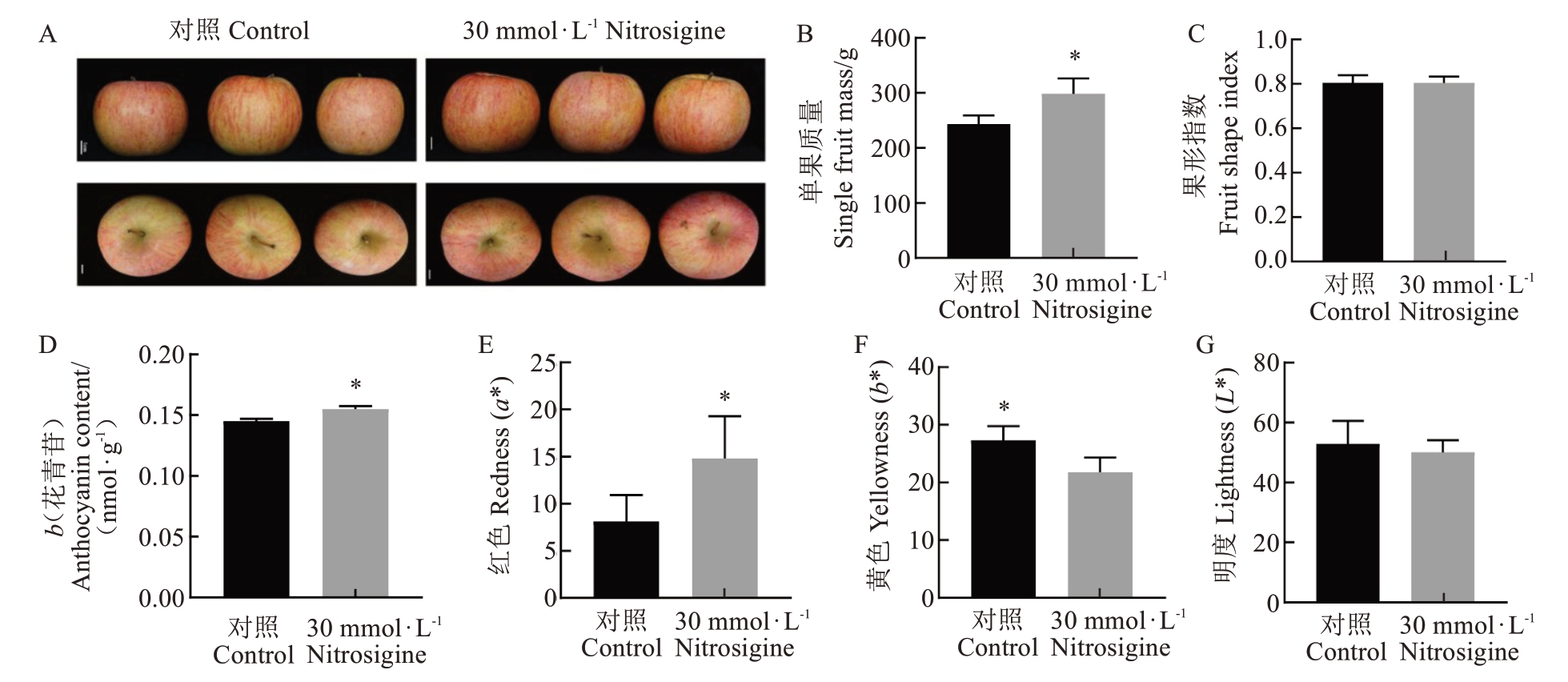
图7 精氨酸硅酸盐肌醇络合物对富士果实外在品质的影响
Fig. 7 Effects of nitrosigine on the external quality of Fuji fruits
2.6 精氨酸硅酸盐肌醇络合物对苹果果实内在品质的影响
如图8~9所示,30 mmol·L-1 Nitrosigine处理的嘎拉苹果果实原果胶含量、果胶总量、果肉硬度、果肉硅含量,分别比对照显著提高了47.59%、41.26%、5.04%、167.88%(图8-B、C、E、G),30 mmol·L-1 Nitrosigine处理的嘎拉苹果可溶性果胶含量、果皮硅含量比对照分别增加了29.55%、103.32%(图8-A、F)。同样的,30 mmol·L-1 Nitrosigine 处理的富士苹果果实果肉硬度、果皮硅含量、果肉硅含量,分别比对照显著提高了8.40%、95.94%、172.5%(图9-E~G),30 mmol·L-1 Nitrosigine 处理的富士苹果可溶性果胶含量、原果胶含量、果胶总量比对照分别增加了34.8%、45.2%、39.84%(图9-A~C)。30 mmol·L-1 Nitrosigine 处理的嘎拉及富士苹果可溶性固形物含量比对照分别显著提高了3.36%、5.82%(图8-H)。30 mmol·L-1 Nitrosigine处理的嘎拉苹果果实可溶性糖、可滴定酸含量比对照分别显著提高了12.75%、24.89%(图8-J~K)。
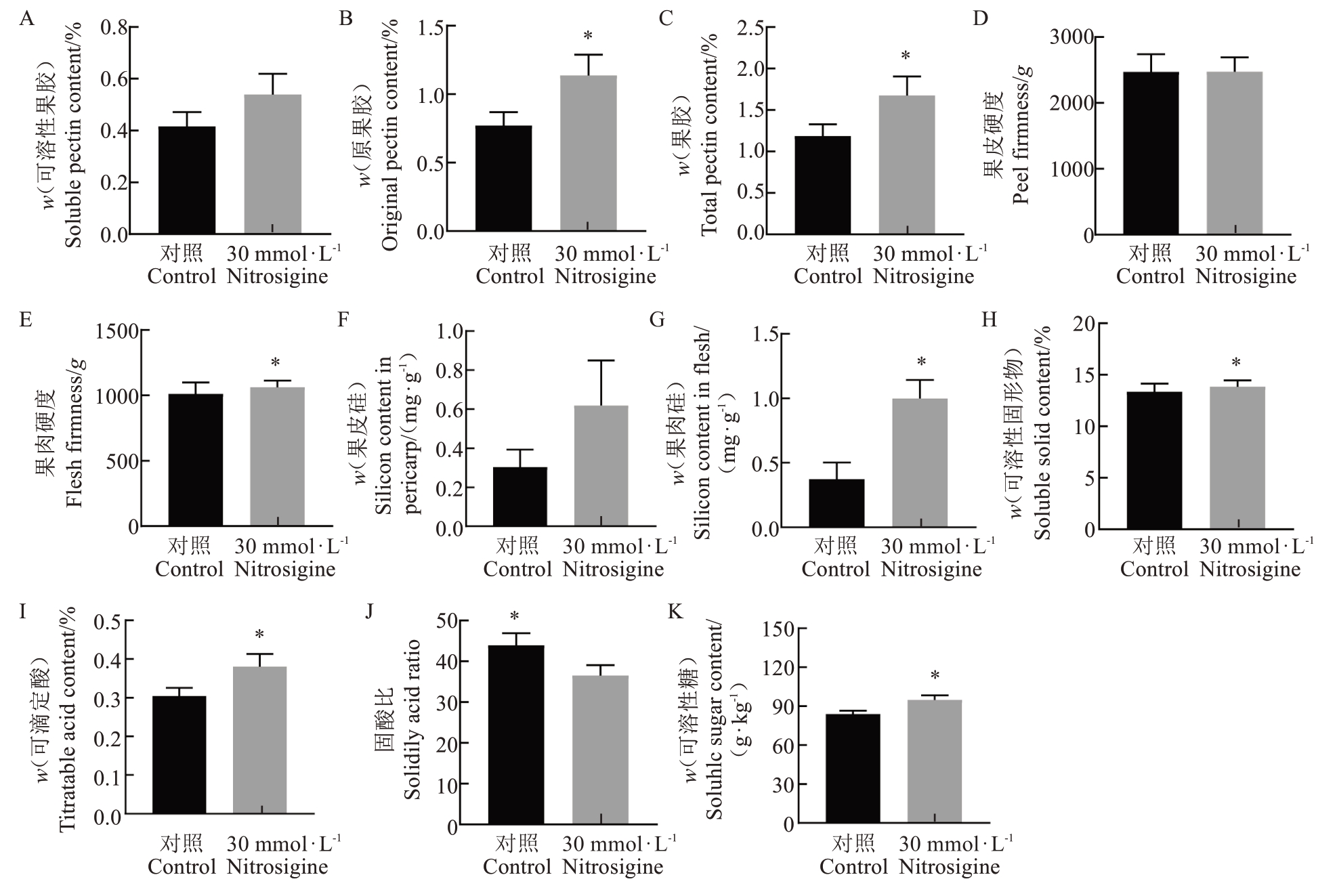
图8 精氨酸硅酸盐肌醇络合物对嘎拉果实内在品质的影响
Fig. 8 Effects of nitrosigine on internal quality of Gala fruits
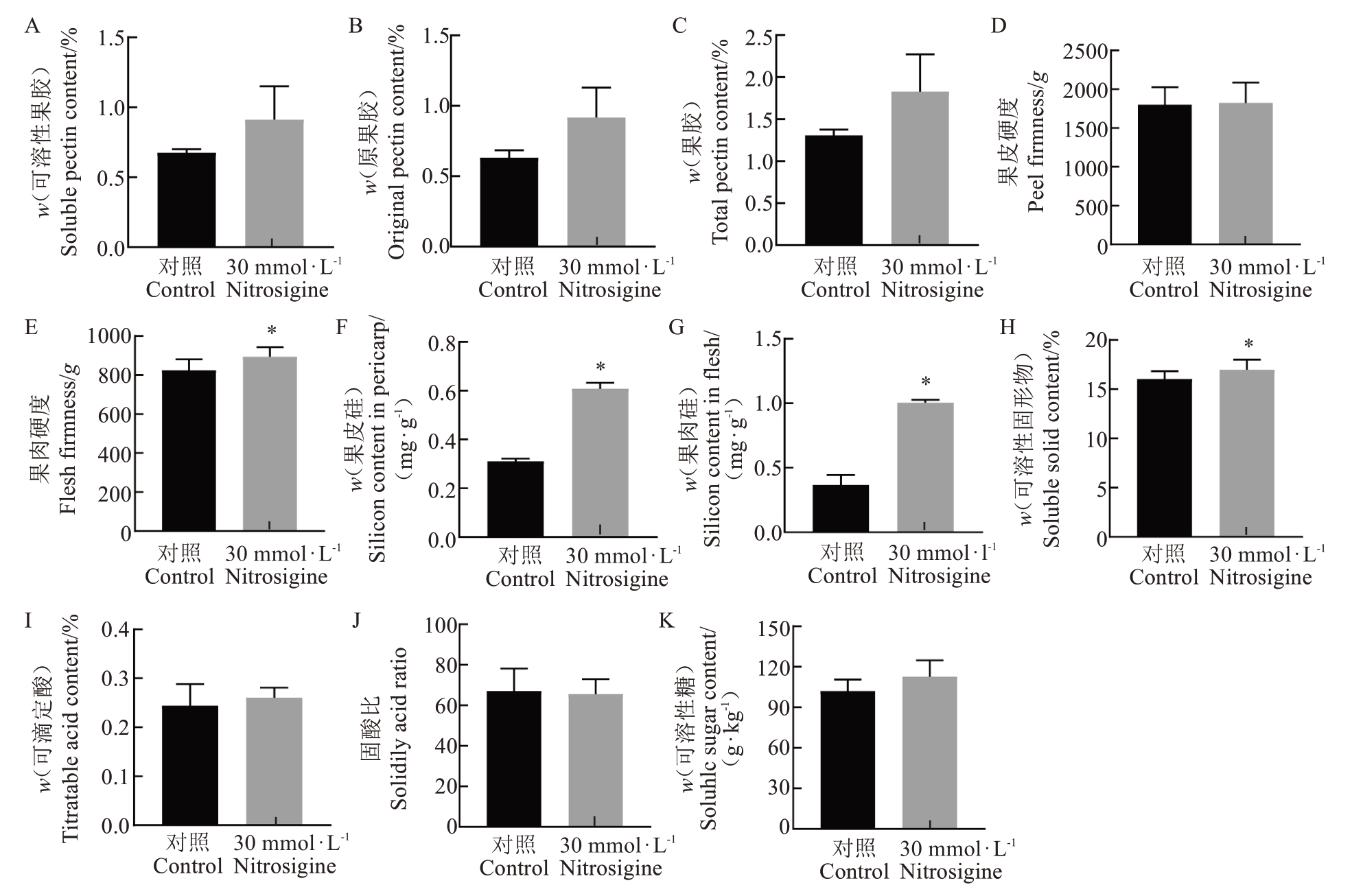
图9 精氨酸硅酸盐肌醇络合物对富士果实内在品质的影响
Fig. 9 Effects of nitrosigine on internal quality of Fuji fruits
3 讨 论
硅作为植物生长的有益元素,能够有效促进植物生长、改善品质、提高产量[26-27]。喷施硅肥可显著促进水稻营养生长,提高水稻分蘖期茎叶干质量[28]。硅肥还可以显著增加玉米硅含量,提高玉米生物量[29]。精氨酸在氨基酸中具有最高的氮碳比,在氮循环中起着重要作用,可为植物补充N 营养。N/Si组合施加可增加植株株高、叶片硅浓度、气体交换量、地上部生物量[30]。在本试验中,Nitrosigine 施用于平邑甜茶幼苗可显著提高幼苗株高、地上部生物量;并显著增加叶面积、叶厚、叶鲜质量,促进叶片生长,进而促进苹果苗营养生长。因此,相较于施用K2SiO3和Arginine,Nitrosigine 可同时为植物补充N和Si,对植物生长促进的效果更明显。
光合作用是植物生长发育过程中重要的物质和能量转换途径,负责植物的生物量生产和整体生长发育。硅可促进植物生长、提高叶绿素和类胡萝卜素含量、增强光合特性(净光合速率、气孔导度、蒸腾速率、水分利用效率)[31-32]。笔者在本试验中对平邑甜茶幼苗叶绿素含量及光合特性进行了测定,K2SiO3、Arginine 及Nitrosigine 处理均可使叶片叶绿素含量增加并提高净光合速率,其中Nitrosigine 处理相较于K2SiO3和Arginine,叶片叶绿素含量、光合效率提升更明显,显著提高了植株光合效率。前人研究结果表明,Nitrosigine能够显著提高Arginine和Si的生物可利用度和吸收率,促进一氧化氮(NO)的产生与循环[21],NO 可以提高植物抗逆性、叶绿素含量与光合效率[33]。外源精氨酸施用可以通过在植物体内转化为氮,从而抑制CHL 降解,提高光合能力和植物生长的效率[34],外源硅施加则可以增强光系统活性,促进光合作用和生物固氮[35]。在本试验中,Nitrosigine 可能促进植物NO 产生,且所含Arginine可为植物提供氮,所含Si 可促进生物固氮、增强光系统活性,以上协同作用共同提高植物光合速率,促进植物生长,但Nitrosigine 促进植物生长的具体作用机制有待进一步试验验证。
增施硅肥和精氨酸不仅可以促进植物生长,还可显著改善水果果实品质[36]。果园施用硅肥可以提高鳄梨果实产量和品质[37];提高桃与富士苹果的花青素、可溶性固形物含量,降低可滴定酸含量[12,38];还可以通过提高甜瓜糖代谢关键酶NI、SPS、SS 活性,从而提高果实糖含量及维生素C 含量[39]。施用精氨酸可增加甜樱桃硬度和可溶性固形物含量,提高果实品质[40-41]。本试验中的Nitrosigine 均可显著提高富士及嘎拉果实花青苷含量及红色色差,促进果实着色,提升果实可溶性固形物及可溶性糖含量,从而提高果实品质。果胶是细胞壁初生壁和中胶层的主要成分,可增加果肉细胞壁稳定性及强度[42],果实果胶含量与果实硬度呈正相关,果胶含量和硬度可影响果实贮藏品质[43],在本试验中,施用Nitrosigine 提高了苹果果皮及果肉硅含量、果肉可溶性果胶及原果胶含量,提高了果肉硬度,对耐贮运性有一定的提升。
4 结 论
精氨酸硅酸盐肌醇络合物处理平邑甜茶幼苗可以显著提高叶片硅含量、叶绿素含量及叶片净光合速率等;提高株高、茎粗、叶面积、地上部生物量等生长指标,促进幼苗生长,以6 mmol·L-1施用浓度效果最好。精氨酸硅酸盐肌醇络合物叶面喷施处理苹果树可显著提高嘎拉和富士果皮花青苷含量,使果实更红;提高了果实可溶性固形物含量、硅含量、果肉可溶性果胶及原果胶含量、果肉硬度等内在品质指标,显著提高苹果果实品质。
[1] 杨安,程存刚,李壮,李燕青,车升国. 鸡粪部分替代化肥改善嘎拉苹果外观品质和风味[J]. 植物营养与肥料学报,2023,29(10):1956-1965.YANG An,CHENG Cungang,LI Zhuang,LI Yanqing,CHE Shengguo. Partial replacement of chemical nitrogen fertilizer with chicken manure improves fruit appearance quality and taste of Gala apples[J]. Journal of Plant Nutrition and Fertilizers,2023,29(10):1956-1965.
[2] 陈毅凡,吴天昊,韩熙睿,俞红,于喜涛,王承国. 山东烟台苹果施肥现状调查[J]. 中国果树,2021(7):91-95.CHEN Yifan,WU Tianhao,HAN Xirui,YU Hong,YU Xitao,WANG Chengguo. Investigation of fertilization status of apples in Yantai,Shandong province[J]. China Fruits,2021(7):91-95.
[3] 姜远茂,葛顺峰,毛志泉,陈学森. 我国苹果产业节本增效关键技术Ⅳ:苹果高效平衡施肥技术[J]. 中国果树,2017(4):1-4.JIANG Yuanmao,GE Shunfeng,MAO Zhiquan,CHEN Xuesen.Balanced fertilization technology of apple[J]. China Fruits,2017(4):1-4.
[4] 李磊,张强,闫敏,冯悦晨,聂督,孙捷. 山西省苹果施肥现状调查[J]. 北方园艺,2018(24):177-185.LI Lei,ZHANG Qiang,YAN Min,FENG Yuechen,NIE Du,SUN Jie. Evaluation of the situation of fertilization in apple fields in Shanxi province[J]. Northern Horticulture,2018(24):177-185.
[5] LIANG Y C,HUA H X,ZHU Y G,ZHANG J,CHENG C M,RÖMHELD V. Importance of plant species and external silicon concentration to active silicon uptake and transport[J]. New Phytologist,2006,172(1):63-72.
[6] 王永刚,康怀启,王会海,程兆东. 硅肥的研究及其在农业生产上的应用[J]. 中国果菜,2018,38(8):48-50.WANG Yonggang,KANG Huaiqi,WANG Huihai,CHENG Zhaodong. Research and application of silicon fertilizer in agriculture production[J]. China Fruit & Vegetable,2018,38(8):48-50.
[7] DU J F,LIU B Y,ZHAO T F,XU X N,LIN H,JI Y T,LI Y,LI Z W,LU C C,LI P G,ZHAO H P,LI Y,YIN Z Y,DING X H.Silica nanoparticles protect rice against biotic and abiotic stresses[J]. Journal of Nanobiotechnology,2022,20(1):197.
[8] ŚWIERCZYŃSKI S,ZYDLIK Z,KLEIBER T. The influence of foliar nutrition of apple trees with silicon on growth and yield as well as mineral content in leaves and fruits[J]. Agronomy,2022,12(7):1680.
[9] MANDLIK R,THAKRAL V,RATURI G,SHINDE S,NIKOLIĆ M,TRIPATHI D K,SONAH H,DESHMUKH R. Significance of silicon uptake,transport,and deposition in plants[J].Journal of Experimental Botany,2020,71(21):6703-6718.
[10] GREGER M,LANDBERG T,VACULÍK M. Silicon influences soil availability and accumulation of mineral nutrients in various plant species[J]. Plants,2018,7(2):41.
[11] WANG M,WANG X D,WANG J J. Effect of silicon application on silicon contents in “Fuji” apple in Loess Plateau[J].Communications in Soil Science and Plant Analysis,2016,47(20):2325-2333.
[12] 唐岩,宋来庆,孙燕霞,刘美英,姜中武. 叶面喷施硅酸钾对富士苹果品质的影响[J]. 落叶果树,2014,46(4):11-13.TANG Yan,SONG Laiqing,SUN Yanxia,LIU Meiying,JIANG Zhongwu. Effect of foliar potassium silicate sprays on the quality of Fuji apples[J]. Deciduous Fruits,2014,46(4):11-13.
[13] KARAGIANNIS E,MICHAILIDIS M,SKODRA C,MOLASSIOTIS A,TANOU G. Silicon influenced ripening metabolism and improved fruit quality traits in apples[J]. Plant Physiology and Biochemistry,2021,166:270-277.
[14] MUSACCHI S,SERRA S. Apple fruit quality:Overview on preharvest factors[J]. Scientia Horticulturae,2018,234:409-430.
[15] MORRIS J S M. Arginine metabolism:Boundaries of our knowledge[J]. The Journal of Nutrition,2007,137(6):1602S-1609S.
[16] LI B B,DING Y,TANG X L,WANG G Y,WU S J,LI X X,HUANG X F,QU T T,CHEN J F,TANG X M. Effect of L-arginine on maintaining storage quality of the white button mushroom (Agaricus bisporus)[J]. Food and Bioprocess Technology,2019,12(4):563-574.
[17] WANG T Q,LIU Q Q,WANG N Q,DAI J,LU Q F,JIA X,LIN L,YU F T,ZUO Y M. Foliar arginine application improves tomato plant growth,yield,and fruit quality via nitrogen accumulation[J]. Plant Growth Regulation,2021,95(3):421-428.
[18] MOHSENI G,OSTADHADI S,IMRAN-KHAN M,NOROUZIJAVIDAN A,ZOLFAGHARI S,HADDADI N S,DEHPOUR A R. Agmatine enhances the antidepressant-like effect of lithium in mouse forced swimming test through NMDA pathway[J]. Biomedecine & Pharmacotherapie,2017,88:931-938.
[19] 麦卡蒂·M,兹林斯基·J. 精氨酸硅酸盐肌醇络合物及其应用:CN1182873C[P]. 美国:2005-01-05.MCCARTY M,ZIELINSKI J. Arginine-silicate- inositol complex and its application[P]. America:CN1182873C. 2005-01-05.
[20] SAHIN K,PEREZ OJALVO S,AKDEMIR F,ORHAN C,TUZCU M,SAHIN N,OZERCAN I H,SYLLA S,KOCA S S,YILMAZ I,KOMOROWSKI J R. Effect of inositol-stabilized arginine silicate on arthritis in a rat model[J]. Food and Chemical Toxicology,2019,125:242-251.
[21] GILLS J L,CAMPITELLI A,JONES M,PAULSON S,MYERS J R,MADERO E N,GLENN J M,KOMOROWSKI J,GRAY M. Acute inositol-stabilized arginine silicate improves cognitive outcomes in healthy adults[J]. Nutrients,2021,13(12):4272.
[22] SAHIN K,ORHAN C,TUZCU M,HAYIRLI A,KOMOROWSKI J R,SAHIN N. Effects of dietary supplementation of arginine-silicate-inositol complex on absorption and metabolism of calcium of laying hens[J]. PLoS One,2018,13(1):e0189329.
[23] 王冠珠. 钙包覆碳量子点提高苹果果实钙吸收及果实品质的研究[D]. 泰安:山东农业大学,2023.WANG Guanzhu. Study on calcium-encapsulated carbon dots to enhance calcium uptake and fruit quality in apple[D]. Tai’an:Shandong Agricultural University,2023.
[24] 安建平. 激素和环境信号调控苹果花青苷生物合成的机理研究[D]. 泰安:山东农业大学,2020.AN Jianping. Study on the mechanism of hormonal and environmental signals regulating anthocyanin biosynthesis in apple[D].Tai’an:Shandong Agricultural University,2020.
[25] 杨文政. 果树生理研究技术[M]. 郑州:河南科学技术出版社,1984.YANG Wenzheng. Research techniques of fruit physiology[M].Zhengzhou:Henan Science and Technology Press,1984.
[26] 范春丽,赵奇. 硅处理对水分胁迫下的苹果幼树生理特性的影响[J]. 北方园艺,2016(5):30-33.FAN Chunli,ZHAO Qi. Effect of silicon on physiological characteristics of apple young trees under drought stress[J]. Northern Horticulture,2016(5):30-33.
[27] 王承业,郑姗姗,李新苗,姜立娜,翟于菲,周俊国. 外源硅处理对不同南瓜砧木苗期生长的影响[J]. 中国瓜菜,2024,37(6):104-110.WANG Chengye,ZHENG Shanshan,LI Xinmiao,JIANG Li’na,ZHAI Yufei,ZHOU Junguo. Effect of exogenous silicon treatment on seedling growth of different pumpkin rootstocks[J].China Cucurbits and Vegetables,2024,37(6):104-110.
[28] FALLAH A,NOORI S,NIKNEJADE Y. Investigation of effects of environment and silicon spray on vegetative growth of rice cultivars in autumn season[J]. Applied Research of Plant Ecophysiology,2016.
[29] VASUDEVAN V,THIYAGARAJAN C. Screening maize hybrids for silicon efficiency to improve the growth and yield on silicon deficient soils[J]. Silicon,2022,14(15):9711-9720.
[30] XU D H,GAO X G,GAO T P,MOU J,LI J H,BU H Y,ZHANG R Y,LI Q X. Interactive effects of nitrogen and silicon addition on growth of five common plant species and structure of plant community in alpine meadow[J]. CATENA,2018,169:80-89.
[31] 徐当会,李秋霞,张仁懿. 硅氮添加对高寒草甸优势物种披针叶黄华生长及净光合速率的影响[J]. 草业科学,2020,37(9):1681-1687.XU Danghui,LI Qiuxia,ZHANG Renyi. Effects of silicon and nitrogen fertilization on the growth and net photosynthetic rate of Thermopsis lanceolata in an alpine meadow[J]. Pratacultural Science,2020,37(9):1681-1687.
[32] RASTOGI A,YADAV S,HUSSAIN S,KATARIA S,HAJIHASHEMI S,KUMARI P,YANG X H,BRESTIC M. Does silicon really matter for the photosynthetic machinery in plants…?[J]. Plant Physiology and Biochemistry,2021,169:40-48.
[33] 于肇端,王丽娜,曹辰兴,胡向阳. 外源一氧化氮对镉胁迫下黄瓜幼苗生长、活性氧代谢和光合特性的影响[J]. 云南植物研究,2009,31(6):486-492.YU Zhaoduan,WANG Li’na,CAO Chenxing,HU Xiangyang.The effects of exogenous nitric oxide on growth,active oxygen metabolism and photosynthetic characteristics in cucumber (Cucumis sativus) seedlings under cadmium stress[J]. Acta Botanica Yunnanica,2009,31(6):486-492.
[34] CHEN Q,WANG Y P,ZHANG Z J,LIU X M,LI C,MA F W.Arginine increases tolerance to nitrogen deficiency in Malus hupehensis via alterations in photosynthetic capacity and amino acids metabolism[J]. Frontiers in Plant Science,2022,12:772086.
[35] WANG B,XIAO L,XU A C,MAO W C,WU Z,HICKS L C,JIANG Y L,XU J J. Silicon fertilization enhances the resistance of tobacco plants to combined Cd and Pb contamination:Physiological and microbial mechanisms[J]. Ecotoxicology and Environmental Safety,2023,255:114816.
[36] DANN E K,LE D P. Effects of silicon amendment on soilborne and fruit diseases of avocado[J]. Plants,2017,6(4):51.
[37] ABIDI W,AKRIMI R,HAJLAOUI H,REJEB H,GOGORCENA Y. Foliar fertilization of potassium silicon improved postharvest fruit quality of peach and nectarine [Prunus persica (L.)Batsch] cultivars[J]. Agriculture,2023,13(1):195.
[38] 刘月,刘海河,张彦萍,李艳超,王亚伦. 外源硅对厚皮甜瓜果实品质及相关酶活性的影响[J]. 中国瓜菜,2021,34(12):28-32.LIU Yue,LIU Haihe,ZHANG Yanping,LI Yanchao,WANG Yalun. Effects of exogenous silicon on fruit quality and related enzyme activities of muskmelon[J]. China Cucurbits and Vegetables,2021,34(12):28-32.
[39] MATYSIAK K,KIERZEK R,SIATKOWSKI I,KOWALSKA J,KRAWCZYK R,MIZINIAK W. Effect of exogenous application of amino acids L-arginine and glycine on maize under temperature stress[J]. Agronomy,2020,10(6):769.
[40] PAKKISH Z,MOHAMMADREZAKHANI S. The effect of preharvest application of arginine on the postharvest quality of sweet cherry fruits during storage[J]. International Journal of Fruit Science,2022,22(1):837-851.
[41] NAROUEI Z,SEDAGHATHOOR S,KAVIANI B,ANSARI M H. Effects of irrigation intervals and foliar application of amino acids and humic acid on the physiological traits of strawberries under colored shading nets[J]. Journal of Berry Research,2022,12(2):187-208.
[42] 赵文哲,陈修德,邓文鹏,吴琦杰,杜桂英,和华杰,王伟,周涛,肖伟,李玲. 外源硅处理对草莓果实果胶物质降解的影响[J].植物生理学报,2021,57(10):1926-1936.ZHAO Wenzhe,CHEN Xiude,DENG Wenpeng,WU Qijie,DU Guiying,HE Huajie,WANG Wei,ZHOU Tao,XIAO Wei,LI Ling. Effect of exogenous silicon treatment on pectin degradation of strawberry[J]. Plant Physiology Journal,2021,57(10):1926-1936.
[43] 叶素银,徐阳春,董彩霞. 钙和硅叶面肥对‘黄冠’梨果实发育期间生理生化变化的影响[J]. 南京农业大学学报,2015,38(5):824-829.YE Suyin,XU Yangchun,DONG Caixia. Effect of foliar calcium and silicon fertilizers on the physiological and biochemical changes in‘Huangguan’pear fruit during the fruit development[J].Journal of Nanjing Agricultural University,2015,38(5):824-829.